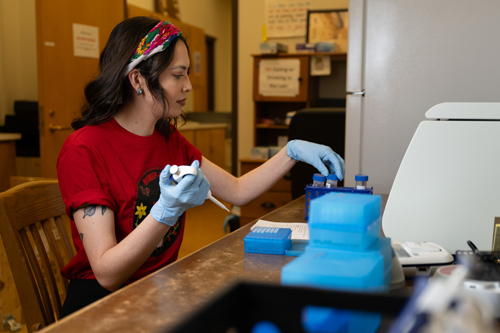When you combine holiday shopping with a global pandemic that started nearly nine months ago, some e-commerce experts are predicting a ‘shipageddon’ of delays and chaos this holiday season.
“There are a lot of things at play here. We have a significant imbalance in the supply chain,” said Scott Grawe, chair of the Ivy College of Business Department of Supply Chain Management and an associate professor of supply chain management.
Grawe sets the stage, just as he does for his supply chain students.
“If you think back to pre-pandemic times, and you step back and look at this not just from a bird’s eye view, but almost a view from the space station and you are looking down at Earth, you see all of the movements of products. They’re going from raw materials to manufacturing sites, to ports, along the highways, to warehouses, to retail stores, to customers. That’s logistics at work – keeping all of the flows in balance.”
The supply chain is always in motion.
A truck driver will arrive at a manufacturing facility, pick up a loaded trailer, take it to a warehouse, drop that trailer off, pick up another trailer, take it to the retail store, drop it off, pick up an empty one, move it back so that everything’s always moving.
“When the pandemic started, things started to shut down. However, it didn’t all shut down at the same time. It came in waves,” Grawe said. “In China, where a lot of our products are manufactured, the manufacturing sites were shut down. People were not allowed to go to work. Nothing was being made in those factories. When nothing is being made, that means nothing is being shipped out of those factories and nothing’s being shipped into them. Everything else around the world continues to move, even though those places are shut down,” Grawe explained.
When they opened back up, they weren’t able to just pick up where they left off.
“They had back orders, because everybody else continued to place orders while factories were closed. Everything backed up in the system. As they came back to work and started to fill back orders, everything else had to catch up,” said Grawe.
The COVID-19 pandemic has presented a unique opportunity for Ivy students to learn about the real-life challenges faced by businesses around the globe.
“I never thought I’d be witnessing so many changes to the supply chain in such a short time,” said Cameron Hillsman, a supply chain major from West Des Moines, Iowa.
“Not being able to click a few buttons and have anything I want show up on my doorstep is a luxury I didn’t know I’d miss,” Hillsman said. “There are so many moving pieces to get my package from a Chinese seller to my front porch, and the pandemic has upended all of them. In class, we learn about just-in-time shipping and manufacturing, which assumes that parts will be available when you need them. Obviously, this is no longer the case. The COVID-19 pandemic is going to force us all to completely reevaluate how we understand and utilize global supply chains, and in the future a supply chain management degree is going to be more important than ever.”
In addition to teaching those real-life scenarios in the classroom, Grawe and his family have experienced supply chain shortages first-hand.
His son suffered an injury during a football game last year, which required knee surgery and a special brace. When it was time to order the brace, Grawe was initially told to expect a four- or five-day delivery, with the brace coming from a warehouse in California. He soon received a notification saying the brace was on backorder.
“I called the company I ordered it from and they said they had approximately 6,000 units on backorder. My response was, wow, that’s a lot of units,” Grawe said.
The wait time was now about eight weeks.
“I can’t just go to another retailer to order that same brace, because they’re all being manufactured from the same place in China,” Grawe said.
Another problem hampering supply chains is the positioning of shipping containers.
“There are trailers and containers out of place because they didn’t have a chance to get back to where they started when people stopped shipping out of China,” Grawe said. “It’s not just about not having the right product available. In some cases, the problem is not having the trailer or the container available to put it in.”
Will this Christmas be different for shoppers?
“Yes, there will be delays. Not all the supply chains are caught up, “Grawe said. “There will be no problems for some of the products and there will be significant delays for others, so I would encourage people to shop early.”
Because many families will not gather in person due to COVID-19, many people will shop online and have their gifts sent directly to the recipient. “That’s going to put a strain on the companies that deliver the products,” Grawe said.
Many people rely on the estimated delivery date, so when it does not arrive on time, people will become frustrated. Grawe encourages patience.
The easiest way to know if your products are available is to shop at local stores. “That is one of the nice things about shopping with brick-and-mortar businesses,” Grawe said. “At a time when people generally don’t feel comfortable going out into public and shopping on Main Street, that’s going to continue to be a challenge. I’m a huge proponent of shopping on Main Street and with other local stores to support them with our business. If you can do it masked up, physically distanced, it’s a great way to make sure that you know what you’re getting.”
For those who shop local, it’s also an option to ship those to friends and family.
“That’s an effective way to make sure that you’re getting what you want for the holiday season,” Grawe said.



